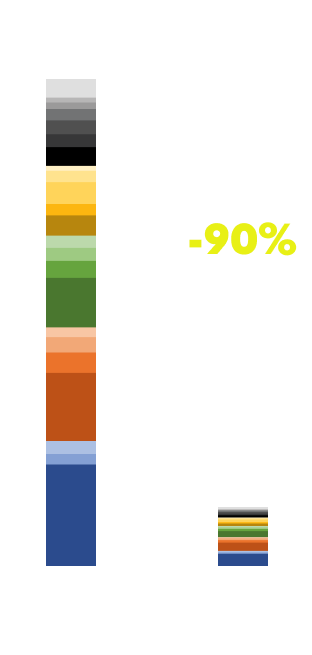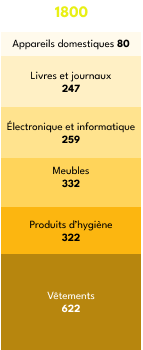If Luxembourg is to achieve its climate targets, we need all of you! Because a task as important as this for society as a whole can only be solved by many players working together. Politics sets the legal framework, helps with subsidies, invests in the necessary green infrastructure and defines a strategic direction. The economy follows suit, modernises and designs its production processes in a climate-friendly way. And the population uses these products and lives in the climate-friendly environment that is created.
However, a number of decisions relating to the climate fall within the private sphere of individuals, which is perfectly normal. Some people find it easier to eat less meat, while others find it easier to go on holiday by train. And yet, some climate actions have a far greater potential for saving money than others. And if we're already working hard to reduce our emissions, we should also do it in a way that makes it really worthwhile!
That's why we're providing you here with information on our carbon footprint, as well as on possible emission reductions.
The beginning of commitment is information.
What is my carbon footprint? Your carbon footprint includes all the GHG emissions associated with your consumption of mobility, housing, food and other goods.
The Ministry of Consumer Protection (MPC) and the Higher Council for Sustainable Development (CSDD) - in collaboration with the Zentrum für politesch Bildung foundation - have each published an online tool for calculating your personal carbon footprint.
These two calculators are adapted to Luxembourg, but are based on slightly different methodologies, because they have two different target groups: The general public and young people in Luxembourg.
MPC carbon footprint calculator for Luxembourg CSDD carbon footprint calculator for young people in Luxembourg For teachers - Work suggestions and ideas for class projects Lifestyle test with advice
The following content and graphics have been taken from the project CarbonNerd of the Luxembourg Institute of Science and Technology.
The consumption-based carbon footprint (shown here) adds up the GHG emissions produced anywhere in the world as a result of consumption in Luxembourg. Another type of carbon accounting is the national inventory, based on production, which includes GHG emissions occurring within the country, whether or not goods produced in Luxembourg are exported.
At 13 t CO2eq per person per year, Luxembourg's carbon footprint is higher than that of our neighbouring countries, currently 11 t in Germany and 8.6 t in France and Belgium.
But why is our carbon footprint so high?
Our footprint is particularly high, for a number of reasons. One is that Luxembourg is a highly developed country with a modern infrastructure. The emissions generated by living in Luxembourg - that is, by using the roads, the various public services or the state apparatus - are distributed equally among all the people who live here. In principle, we can all benefit from these services.
Another reason is that the average income in Luxembourg is higher than in neighbouring countries, which allows people to consume more in all areas (home, transport, food, consumer goods). The rule is simple: more consumption = more emissions.
What's your carbon footprint? Do the math!
Some sectors will still be producing GHG emissions in 2050, and these will have to be offset by absorbing or sequestering CO2 to achieve climate neutrality.

STATEC has published Luxembourg's carbon footprint in 2023 in its publication « The environment in figures ». It uses a top-down methodology and arrives at an estimate of around 20 to 23 t CO2eq per person. This figure is higher than the estimate of 13 t CO2eq per person from the Luxembourg Institute of Science & Technology, which uses a bottom-up estimation methodology. Whatever the case, it is clear that we need to reduce our carbon footprint considerably to reach net-zero.
What is the impact of the various climate actions?
Here are some estimates from the Luxembourg Institute of Science and Technology as part of their CarbonNerd project.
* Even if organic farming has no significant impact on GHG emissions, However, it also offers other environmental benefits, such as biodiversity.
|
Mobility
220
Cycling instead of driving for longer distances <5 km
670
Taking the train instead of the plane on holiday
750
Carpooling
1500
From diesel to electric cars
1780
Commuting by train instead of car
|
Housing
30
Turning off the lights
30
Unplug appliances
90
Drying clothes on a line
1030
Switching to a heat pump
1729
Improving insulation
|
Power supply
0
Buy organic*
40
Buying in bulk
40
Eating locally
80
Stop food waste
1320
Switching to a vegetarian diet
|
Consumer goods
20
Doubling the lifespan of a smartphone
30
Reducing video games
30
Reduce film streaming
310
Buy 50 % less clothes
510
Buy second-hand for 1/3 of products
|

Martin
-110 kg CO2eq
30 kg CO2eq
turns off the lights when it leaves a room
40 kg CO2eq
buys shampoo and detergent in recycled bottles or with reduced packaging
40 kg CO2eq
buys organic and/or local fruit and vegetables
|

Carla
-1920 kg CO2eq
1780 kg CO2eq
uses public transport for its daily commute
60 kg CO2eq
avoids using your smartphone
80 kg CO2eq
avoids food waste
|

Naima
-3830 kg CO2eq
2000 kg CO2eq
Cycling or using public transport
510 kg CO2eq
buys second-hand clothes, books and furniture
1320 kg CO2eq
no longer eats meat
|






